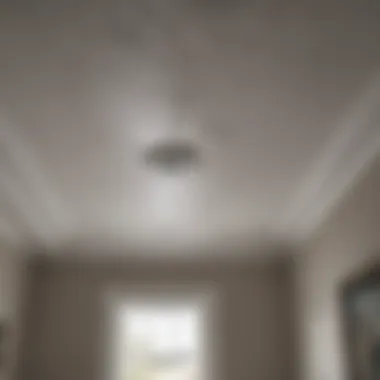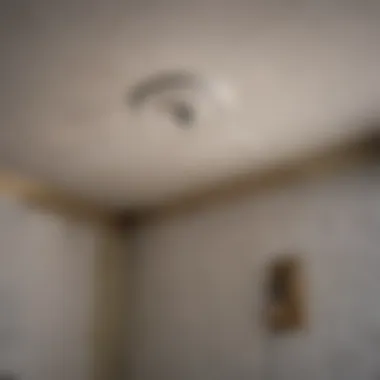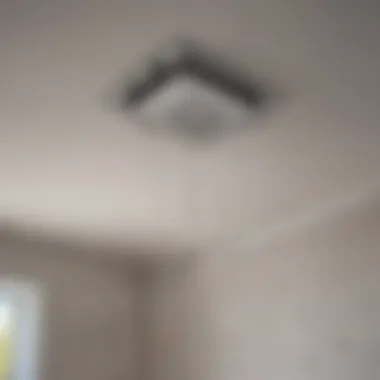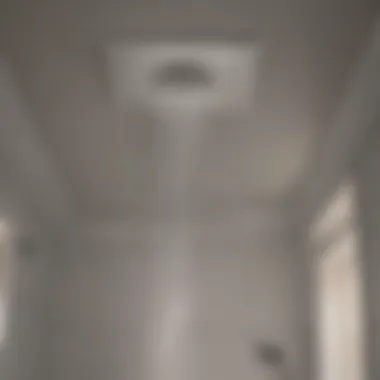Effective Strategies for Fixing Ceiling Leaks


Intro
A ceiling leak can be the worst nightmare for any homeowner, especially when the source is traced back to an upstairs bathroom. It generally doesn’t ring any bells until that tell-tale drip starts to cause real concern. Whether it's water stains on the ceiling or a constant drip flooding your ideas for weekend relaxation, identifying and addressing this issue promptly is crucial. This guide will shed light on practical approaches to tackle this pesky problem, providing homeowners and DIY enthusiasts the confidence to act.
Understanding the Importance of Early Detection
Catching a leak early can save a bundle in repairs down the line. The key is keeping an eye out for signs that might indicate something is off above your head.
- Water Stains: Look for dark patches that spread on your ceiling.
- Bubbling Paint: A sure sign that moisture is seeping through.
- Mold Growth: If you spot mold, it’s already a signal you need to investigate.
By being vigilant about these signs, the chance of mitigating extensive damage increases significantly.
Potential Causes of Ceiling Leaks
Addressing a leak effectively requires understanding where it originates. Here are some likely culprits to consider:
- Faulty Fixtures: Toilets, sinks, and showers often contribute to leaks if the seals or connections wear out.
- Piping Issues: Old pipes can corrode or develop cracks over time leading to slow leaks.
- Condensation: In humid bathrooms, water can condense on cold pipes, eventually dripping down.
With awareness, it becomes easier to locate the problem's root cause and tackle repairs.
Repair Strategies
Step 1: Identify the Problem Area
Begin by investigating the suspected source. Shut off the water supply to the bathroom to stop any further leakage. Check behind the wall and around fixtures for signs of dampness. It can be helpful to inspect pipes while running a tap to find inconsistencies.
Step 2: Fix the Leak
Depending on the cause of the leak, here are common repairs you might execute:
- Replacing Fixtures: If a toilet or sink is the problem, you might need to replace the washers or entire units.
- Repairing Pipes: For small cracks, epoxy putty can be a temporary fix. For serious damage, repiping may be needed.
- Controlling Condensation: Insulating cold pipes can help prevent moisture build-up.
Step 3: Restore the Ceiling
Once the source is handled, the ceiling will likely need some attention. Stains can often be painted over, but it may require deeper repairs if it is extensive. For severe damage, replacing sections of drywall might be the best course of action. Always allow adequate time for any repairs to dry before further work.
"An ounce of prevention is worth a pound of cure."
Preventive Measures
To avoid similar issues in the future, take these proactive steps:
- Regular Inspections: Make it a habit to inspect fixtures and plumbing periodically.
- Proper Ventilation: Ensure your bathroom is well-ventilated to reduce humidity.
- Sealant Maintenance: Keep an eye on seals around tubs and sinks to prevent leaks before they start.
End
Addressing a ceiling leak from an upstairs bathroom requires a careful investigation and timely action. Homeowners that equip themselves with knowledge about spotting potential issues can tackle these problems head-on. With the right tools and a bit of elbow grease, maintaining a leak-free home is entirely feasible. Remember, it is always better to address these matters sooner rather than later, ensuring your living space remains safe and sound.
Understanding Ceiling Leaks
Ceiling leaks are more than just unsightly stains that make one sigh about home maintenance. They can be a porthole to larger, hidden problems that might break the bank if not caught early. Understanding the realm of ceiling leaks encompasses grasping their definition, identifying sources, and recognizing the urgency behind prompt repairs. In some cases, the leak might simply stem from worn caulking around a bathtub, while in others, it could indicate burgeoning plumbing catastrophes lurking beneath walls.
The importance of pinpointing the source cannot be understated. Knowledge is your best ally here. Homeowners who can identify a leak before it turns into a full-blown mess not only save time but also spare themselves the financial headaches that often crop up when unexpected repairs start piling up. Prevention is the name of the game. By understanding ceiling leaks inside and out, one can avoid the common pitfalls that typically lead to significant water damage.
Definition of a Ceiling Leak
A ceiling leak occurs when water penetrates through the ceiling, usually originating from an upper level. Consider it a sign of impending trouble that demands immediate attention. It can manifest as a drip of water, an annoying stain on the ceiling, or—in some unfortunate cases—a more severe issue like mold growth. The significance of recognizing a ceiling leak lies in its potential to escalate into more severe damage if left unchecked. To put it simply, it’s a warning bell for homeowners to take action promptly.
Common Sources of Ceiling Leaks
Identifying the source of a ceiling leak can significantly streamline the repair process. There are a few common culprits that tend to rear their ugly heads more often than not.
Bathroom fixtures
Bathroom fixtures are often the first suspect in ceiling leaks. From faucets to showerheads, these are frequent sources of slow yet persistent leaks. A simple faucet drip might seem harmless, but over time, it can lead to unattractive stains and eventually structural rot if not fixed.
A key characteristic of these fixtures is their intimate involvement with water usage—meaning they experience wear and tear more regularly. While their replacement or repair can be relatively straightforward, homeowners need to understand they might just be skirting the surface of a larger issue if their plumbing system is not up to snuff. These fixtures require regular maintenance and occasionally need replacing parts to minimize leaks.
Plumbing issues
Plumbing issues are often at the heart of ceiling leaks. A faulty pipe, a loose connection, or an aging system can lead to significant water damage that isn’t immediately obvious. Pipes that run through walls and ceilings may corrode over time and create leaks that trickle down, manifesting as water stains.
The constant pressure on plumbing materials means they endure much more stress than one might imagine. A proactive approach, including regular inspections, can help identify potential weak points before they can wreak havoc. Though repairing plumbing does require an investment of time and some expertise, its advantages outweigh the inconvenience of possible damage mitigation down the line.
Roof leaks
Lastly, roof leaks can also result in water seeping through ceilings, especially in multi-level homes. This type of leak might arise from damaged shingles, improper sealing, or even gutters that haven't been cleaned. It’s curious how a compromised roof can lead to myriad issues within the home.
Roof leaks often manifest more slowly than plumbing ones, making them seem less urgent. However, that slow trickle can still create long-term structural damage. The uniqueness of a roof leak lies in its ability to go undetected for an extended period as water travels through the structure before finally showing up as a stain on the ceiling. Homeowners need to adopt a routine roof checkup plan to nip these leaks in the bud before they escalate into a larger problem.
Ultimately, becoming educated about ceiling leaks equips homeowners with the knowledge needed to not only respond to them appropriately but also to prevent them from recurring.
Identifying Signs of a Leak
Recognizing the signs of a leak is essential for any homeowner, especially when it relates to a ceiling leak from an upstairs bathroom. The quicker you identify the leakage, the easier it’ll be to address. Ignoring these signs can lead to prolonged water damage, structural issues, and costly repairs. By paying attention to both visual indicators and auditory cues, you can take proactive measures to protect your home.
Visual Indicators


Discoloration Patterns
Discoloration patterns on the ceiling can tell you more than you might think. These usually appear as dark spots or rings that suggest moisture has begun to seep through the ceiling. The key characteristic of discoloration patterns is their ability to change over time, worsening as the leak persists. This can be beneficial for identifying the extent of a leak; if the patterns enlarge or evolve in color, it signals escalating issues that need immediate attention.
For instance, a small yellowish circle may expand into a darker patch, enunciating the urgency for repairs. However, while it provides great insight into your ceiling’s condition, it can also be misleading. Sometimes a benign water stain could appear due to humidity rather than a leak.
Stains on the Ceiling
Stains on the ceiling represent another critical sign of water intrusion. They can manifest as brown or yellow-brown patches that develop underneath plumbing fixtures, indicating leaks. The main characteristic here is their permanence; these stains often don’t fade quickly, marking a serious issue.
What makes stains a prominent topic for this article is their potential to reflect ongoing or repeated water issues. They can be treated with paints and primers, although that might only mask the problem instead of resolving it. Thus, if one sees a stain, it’s a heads-up for deeper investigation.
Peeling Paint or Wallpaper
Peeling paint or wallpaper can be a less-obvious but equally telling sign of a leak. When water is constantly interacting with these surfaces, it can cause them to bubble up and eventually peel away. The distinguishing feature of this is that it often indicates not just a leak but a longstanding issue that has been ignored.
This can be particularly beneficial for homeowners as peeling paint or wallpaper serves as both a symptom and a remedy signal. Homeowners should be aware that while repainting can resolve the surface issue, it does little to fix the underlying plumbing concern.
Auditory Cues
Dripping Sounds
Dripping sounds provide auditory confirmation that something is amiss. This distinct noise can be an early warning, prompting immediate investigation. The key characteristic of these sounds is their consistency or irregularity. A steady dripping noise indicates a significant source, while sporadic drips may suggest fluctuations in water pressure or an intermittent leak.
The benefit of catching these sounds early is in avoiding substantial damage. If you hear dripping, it is crucial to act. However, the downside is that not every dripping sound comes from a leak; it could be from condensation or other normal bathroom sounds.
You May Hear Water Flowing
When you hear water flowing when no faucets are running, it can be particularly alarming. You may think everything is okay until you notice it more frequently. This sound is a crucial indicator of potential leaks within pipes. Its defining characteristic is a consistent noise, often making you wonder if something is malfunctioning.
The remarkable aspect of this auditory cue is its capability to alert homeowners to plumbing issues even before they become visible. Ignoring this might lead to complex problems, so addressing it quickly is vital. However, it can also be misleading on occasion, as the sound may vary based on ongoing everyday water use in other areas of the house.
Assessing the Situation
When dealing with a ceiling leak from an upstairs bathroom, taking a moment to assess the situation is crucial. This step is not just a precursor to repair but a way of gathering insights that can save time and prevent further damages. If you don't assess, you might fix one problem only to have another fishy issue pop up later, like a surprise guest at your party. Here’s why this assessment is so vital.
First and foremost, an effective assessment allows you to pinpoint the source of the leak. Is it a plumbing issue, or maybe something structural? Knowing where the trouble lies helps streamline your approach to repairs. Plus, understanding the extent of the damage can save you from engaging in a larger project than what meets the eye. For instance, a small stain may seem harmless, but it could stem from significant leakage.
Inspecting the Bathroom
Check the shower and tub
The shower and tub are often the culprits when it comes to leaks in bathrooms. They involve multiple connections and are in constant contact with water. Start by inspecting the seals and caulking around them, ensuring everything's intact. One key characteristic of this inspection is how crucial it is to identify small cracks or gaps. Even the tiniest of openings can lead to significant troubles down the line.
With this process, you're not just checking for leaks but actively participating in the preventative maintenance of your home. A small chip in the tub or a worn-out seal could lead to water trickling into the ceiling beneath, causing stains that are hard to ignore. Therefore, taking a close look at the shower and tub becomes a beneficial choice, as addressing these issues now can save you time and headache later on.
Examine all plumbing fixtures
Similarly, examining all plumbing fixtures holds immense significance in identifying leaks. Each joint, pipe, or fitting can hide a potential problem. The unique feature here is the interconnectedness of your plumbing; a flaw in one area can wreak havoc throughout the entire system. Checking your sink, faucet, and even the toilet can reveal small leaks that haven’t yet manifested visibly in your ceiling.
This thorough inspection is both practical and wise. You’re effectively getting ahead of the curve. By tightening fittings or replacing faulty parts, you can stop a minor inconvenience from becoming a costly repair. Thus, it’s clear that examining all plumbing fixtures is a smart strategy in managing your home’s plumbing health.
Investigating the Ceiling
Look for sagging areas
Now, let’s shift the focus upwards to the ceiling itself. One specific aspect to look for is sagging areas. This is an important indicator of a serious leak. A sagging ceiling can mean that water has been pooling, weakening the structure. The key characteristic of this concern is the visible signs that your ceiling presents, showing that it’s taking a beating from above. Pay attention; this is critical.
Noticing sagging can prompt immediate action. If ignored, it may lead to more extensive repairs, both to the ceiling and maybe even the floor above. Addressing sagging areas promptly can be a beneficial strategy, ensuring the safety and integrity of your home, keeping you and your family cozy and secure.
Assess the texture of the paint
Finally, assessing the texture of the paint provides another layer of understanding. When paint begins to bubble, flake, or change texture, it often signals underlying moisture issues. The unique feature of this inspection is that you may glean information about the leak’s duration. For instance, if the paint is peeling away, it could indicate a long-standing issue that requires urgent attention.
By paying heed to these preliminary signs, you will not only enhance your immediate understanding of the leak but also establish a baseline for what repairs are necessary. This step is simple yet crucial for maintaining the aesthetics and structural integrity of your home.
Tools and Materials Required
Addressing a ceiling leak isn’t just a matter of saying a few magic words; it often involves a careful selection of tools and materials. Choosing the right items can make all the difference when it comes to diagnosing and fixing water damage from above. So let’s dive into what you need, along with the reasons each item matters.
Basic Tools
Your toolbox is your first line of defense. These are the essentials you'll need to tackle the problem effectively.
Screwdriver
A screwdriver might seem like a no-brainer, but it serves multiple important roles during repair.
- Key Characteristic: It's the most versatile tool you’ll have in your kit.
- Why It's Popular: Whether tightening screws on a loose fixture or removing plates to examine plumbing, it’s invaluable.
- Unique Feature: Many come with interchangeable heads, making it adaptable to various screws.
However, be cautious using it for excessive force; the wrong angle can strip the screws you are trying to tighten, making it a bit of a double-edged sword.
Wrenches
When dealing with plumbing, nothing beats the effectiveness of a good wrench. This tool is crucial for providing the grip and torque needed.
- Key Characteristic: Wrenches offer the ability to turn nuts and bolts securely.
- Why It's Popular: They are known for snugly fitting around all kinds of fittings, making life easier.
- Unique Feature: Adjustable wrenches can fit various sizes of nuts, allowing you to conserve space in your toolkit.
Cleaning and maintaining these tools is essential; any rust or residue can impede their performance, which can be a real pain when you're already stressing over leaks.


Drill
If you’re looking to do any kind of significant repairs, you’ll find a drill to be a true lifeline.
- Key Characteristic: The power and speed it offers make installing and removing fixtures much simpler.
- Why It's Beneficial: It cuts through multiple materials, from wood to drywall, helping in diverse repairs.
- Unique Feature: Many drills offer variable speeds, letting you control the amount of torque effectively.
On the downside, if you’re not careful, a drill can make holes that are too large for their intended purpose; so go easy!
Repair Materials
The right repair materials can be the backbone of a successful leak fix. These considerations ensure the longevity and effectiveness of your repairs.
Sealants
Sealants play a key role in preventing water from wreaking havoc in your home.
- Key Characteristic: They create a waterproof barrier, sealing gaps between surfaces.
- Why They’re Popular: A good sealant can save you from future headaches as it helps ensure everything stays in its place.
- Unique Feature: Some sealants expand upon curing, filling in gaps you might have missed.
Be mindful; if the surface isn’t prepped correctly, these products won’t adhere properly, leading to another leak before you know it.
Drywall patches
Drywall patches are your go-to for covering any holes or damage caused by the leak.
- Key Characteristic: They come in various sizes and shapes to fit specific needs.
- Why They’re Beneficial: They allow for a seamless repair that blends into the existing ceiling beautifully.
- Unique Feature: Some patches come with adhesive backs, making installation a breeze.
However, if not applied correctly, these patches can create bumps or uneven textures that stand out.
Paint and primer
The final touch can make or break a project. Painting over the repaired ceiling is essential not only for aesthetics but also for durability.
- Key Characteristic: Good quality paint can often resist moisture better than the standard options.
- Why It’s Popular: It enhances the overall look and provides a protective layer against future leaks.
- Unique Feature: Primers often improve adherence and longevity when paint is applied over drywall repairs, ensuring a more durable finish.
Don't skimp on quality; cheap paints may fade or peel much faster than you expect, necessitating more frequent touch-ups.
When it comes to addressing a leak, having the right tools and materials is non-negotiable. Their effectiveness can mean the difference between a quick fix and a prolonged headache.
Repairing the Leak
Repairing a ceiling leak is an essential step in home maintenance that shouldn't be overlooked. If left unchecked, even the smallest leak can evolve into a cascade of problems, affecting the structural integrity of your home. The importance of promptly addressing such leaks cannot be stressed enough; it not only saves money on potential damage down the road but also ensures a safe and comfortable living environment.
When dealing with a ceiling leak, the first course of action one should take is to shut off the water supply. This minimizes further damage and allows for a more accurate assessment of the situation. While it might seem like a simple step, it sets the groundwork for all subsequent repairs.
Furthermore, dealing with plumbing issues such as replacing faulty pipes and tightening loose fittings is crucial for halting any ongoing leaks. Beyond fixing what’s immediately visible, it ensures that the underlying problems are effectively addressed, leading to long-term solutions and peace of mind.
Lastly, the appearance of the ceiling should not be neglected. Removing damaged drywall and applying new drywall patches aren’t just cosmetic repairs; they also prevent mold growth and uphold the aesthetic appeal of your living space. All these elements contribute to a well-rounded approach in tackling ceiling leaks, making repair efforts not just reactive but also proactive.
Shutting Off Water Supply
Shutting off the water supply is a minor yet mighty task when faced with a leak. This action halts further flow of water into the affected area, buying you crucial time. It’s always wise to locate the main shut-off valve which can usually be found in the basement or on an exterior wall of your house. By doing so, you avoid transforming a minor inconvenience into a small swimming pool in your upstairs bathroom.
Fixing Plumbing Issues
When it comes to fixing plumbing issues, there are two main strategies that should be considered: replacing faulty pipes and tightening loose fittings. These efforts will not only fix existing leaks but also prevent future mishaps.
Replacing faulty pipes
Replacing faulty pipes is essential when deterioration or damage has taken its toll. This task may seem daunting, but it’s a vital step in ensuring your plumbing system remains intact. The key characteristic of replacing pipes is its effectiveness in eliminating stubborn leaks and enhancing overall water flow.
When you take this route, you are choosing durability and reliability. New pipes can significantly reduce the likelihood of future leaks, saving you both time and money in the long run. One unique feature of modern pipes, such as those made from PEX or copper, is their resistance to freezing and corrosion, providing additional longevity.
However, replacing pipes can be labor-intensive and, admittedly, costly. Homeowners need to weigh the benefits against the expenses involved, with a clear understanding that the upfront cost often pays itself off in avoided repairs.
Tightening loose fittings
On the other hand, tightening loose fittings is an easier and faster fix. It’s often surprising how much a few twists of a wrench can eliminate leaks. The key characteristic of this approach lies in its simplicity and immediate impact. Loose fittings usually lead to minor leaks that can escalate if ignored.
This method is popular among homeowners next to full replacements, offering a quick stopgap solution. It's advantageous in its accessibility; anyone with basic mechanical skills can usually tighten fittings without professional help. However, it’s essential to note that this is often just a temporary fix. Over time, fittings can loosen again or deteriorate, necessitating deeper repairs or replacements down the line.
Addressing Ceiling Damage
Addressing ceiling damage is not just about aesthetics; it’s a matter of safety and longevity too.
Removing damaged drywall
When it comes to repairing the ceiling, removing damaged drywall is an integral first step. If your drywall is saturated or moldy, it should be taken out immediately to prevent any health hazards. The key characteristic here is ensuring a solid base for repairs. Removing the affected section means you're starting fresh, allowing for proper drying and treatment.
This approach is not only beneficial but crucial, as failing to address damaged drywall can lead to further complications like mold growth. It’s a choice that prioritizes your home’s health and integrity. The downside, of course, is the effort and mess involved in this undertaking.
Applying new drywall patches
Once you’ve taken out the bad parts, your next mission is applying new drywall patches. This task serves as a safeguard against future leaks as well as helping maintain the visual appeal of your ceiling. The unique feature of new drywall patches is their ability to blend seamlessly with the existing ceiling, provided proper techniques are followed.
Furthermore, this not only resolves visible concerns but acts as a deterrent for mold and mildew. However, it requires careful application and often a little bit of finesse with tools like joint compound and tape to achieve a professional finish. So, while doing this might save costs on labor, it demands a good bit of skill and patience.
Repairing the leak and subsequent ceiling damage can be a fulfilling endeavor for homeowners. It’s about creating a safe environment while gaining the satisfaction of having tackled home repairs head-on.


Finishing Touches
After dealing with a ceiling leak, the final step involves wrapping up the repair process with thoughtful finishing touches. This portion is crucial not just for aesthetics but also for ensuring that the repairs hold up over time. From sealing and painting to conducting a meticulous final inspection, each step serves as a seal of quality on your hard work. Neglecting these aspects could lead to future issues, so let's unpack them in a bit more detail.
Sealing and Painting
Applying primer
When it comes to applying primer, you want to think of it as a shield for your newly repaired ceiling. Primer promotes better adhesion of paint, which is particularly important in areas that may have met water. The primary characteristic of primer is its ability to create a porous surface, allowing the subsequent layers of paint to grip more effectively.
Using primer can keep your paint job looking fresh for a much longer time, making it a popular choice among DIY home repair enthusiasts. The unique feature of most primers is their resistance to mildew and mold – a must in damp areas like bathrooms. While it does require an extra step in the process, the benefits overwhelmingly outweigh the minor inconvenience. Plus, choosing the right kind of primer helps prevent any discoloration caused by the underlying stains from the leak.
Selecting appropriate paint
Selecting the right paint is another critical aspect of finishing touches. The paint you pick will not only bring a fresh look to the ceiling but also provide protection against moisture. One key characteristic to look for is mold and mildew resistance. This is particularly beneficial in bathrooms where humidity levels can rise faster than you can say "leaky faucet."
The unique feature of high-quality ceiling paints is that they often have a flatter sheen, helping to hide imperfections left behind from the repairs. It's important to note that some paint types claim to be easy to clean, but they may not be as effective in high moisture areas. Choosing the wrong paint can lead to peeling, bubbling, or worse, mold lurking in the corners. Picking an appropriate paint isn’t just about color; it’s about durability and longevity.
Final Inspection
Checking for leaks
Checking for leaks after making your repairs is a step that cannot be bypassed. This examination validates your efforts and guarantees that the problem is indeed solved. The primary characteristic of this task is that it requires a keen eye and occasionally a damp cloth to test for residual moisture. It's beneficial because it assures you that no new issues are lurking just around the corner.
The unique feature of a thorough leak check is that it often involves multiple inspection points. You're not just looking at the immediate area, but also checking adjoining rooms or spots that could have been affected by the water. The advantage of conducting this step is that you avoid unpleasant surprises down the road. On the flip side, a rushed inspection often leads to missed leaks and a return to square one - it's worth taking the time.
Assessing quality of repair
Assessing the quality of your repair job brings everything full circle. This stage confirms whether your previous efforts have resulted in a solid fix or if additional work is necessary. A vital characteristic here is ensuring that no visible seams or bulges remain on the ceiling. This does more than just promise a good appearance; it offers long-lasting integrity to the structure.
One distinct advantage of a solid assessment is that it prepares you for future maintenance. You'll gain insights into how well your materials held up over time, which can inform your decisions on future DIY projects. If you rush through this, however, you could face recurring problems, making it a disadvantage to neglect this step.
Taking the time to properly assess everything ensures you’re not only solving the issue this time but preventing future headaches.
In summary, the finishing touches in addressing a ceiling leak are not just about making things look nice. They play a pivotal role in ensuring that your repairs stand the test of time. From sealing and selecting the right paint to diligent inspections, these steps are essential elements of a complete repair process.
Preventative Measures
Addressing ceiling leaks isn't merely a reactive problem that one encounters when the damage is already done. It’s essential to adopt preventative measures that keep leaks at bay in the first place. Engaging proactively equips homeowners with invaluable knowledge, ensuring they maintain a dry and cozy space upstairs and below. After all, an ounce of prevention is worth a pound of cure. There are key areas where focusing efforts can save not only hassle and frustration but also potential financial strain in the future.
Maintaining Plumbing Systems
Regular inspections
Regular inspections form the backbone of any maintenance strategy for plumbing systems. Think of it like giving your home a health check-up; without it, minor issues might fester into significant problems. The uniqueness of regular inspections lies in their preventive capacity. By checking pipes, joints, and fixtures routinely, you’re likely to spot small leaks or signs of wear before they escalate, sparing yourself from potential extensive repairs. This proactive approach means that you can keep your plumbing systems performing smooth and effectively for years to come.
However, don’t simply rely on visual checks. Think beyond the surface—pay attention to the sound of your pipes. A change in noise could indicate an impending problem. For homeowners, scheduling these inspections at least once a year is a beneficial strategy that keeps future headaches at bay.
Immediate repairs of minor leaks
Immediate repairs of minor leaks cannot be stressed enough in the realm of home maintenance. It’s akin to putting a band-aid on a cut before it gets infected. Such small leaks might seem trivial when they’re just dripping slowly, but ignoring them can quickly lead to more severe issues, like water damage and mold growth.
A standout feature of dealing with small leaks promptly is the cost-efficiency it provides. Often, addressing a minor leak requires lower investment and is typically a straightforward fix. Moreover, consistently taking care of these small problems helps cultivate a sense of responsibility towards upkeep, thus prolonging the lifespan of your plumbing installations.
Another aspect to keep in mind is that addressing minor leaks not only prevents potential damage but also contributes to a more sustainable household. Wasting water is never ideal, and fixing leaks immediately reduces water wastage, which can reflect positively on the water bill.
Improving Bathroom Ventilation
Using exhaust fans
Ventilation is tremendously crucial in moisture-heavy areas like bathrooms. Using exhaust fans is one of the best strategies to combat the dampness that leads to ceiling leaks. These fans work diligently to remove excess moisture from the air, which can result from showers and baths.
One distinct benefit of exhaust fans is their role in preventing mold growth, which loves to thrive in humid conditions. By keeping the air in your bathroom dry, you also reduce the risk of leaks forming due to constant moisture accumulation in the ceiling below. Regular use of exhaust fans is particularly beneficial, especially during and after bathing, as this keeps humidity levels in check.
Decreasing humidity levels
Decreasing humidity levels serves as another pivotal tactic in preventing leaks. High humidity not only affects the air quality but also contributes to moisture accumulation that can ultimately lead to ceiling leaks. To tackle this aspect, homeowners can consider using dehumidifiers.
The prime characteristic of managing humidity effectively is ensuring the home feels more comfortable while simultaneously protecting structural integrity. A unique feature of lowering humidity is that it doesn't require aggressive alterations in the home setup. Simple actions, like regularly opening windows or using dehumidifying products, can lead to significant changes.
Additionally, decreasing humidity helps in retaining the quality of paint and wallpaper, prolonging the time it takes before further maintenance or touch-ups are needed. This, in the long run, saves effort and costs associated with repairs.
Remember: Regular checks and prompt repairs on minor leaks, combined with effective ventilation, hold the key to preventing leaks and maintaining a healthy home environment.
End
Addressing a ceiling leak from an upstairs bathroom is a crucial task that every homeowner should prioritize. It’s not just about fixing the immediate problem; it's about safeguarding your home’s structural integrity and preserving one’s living space. Ignoring a leak can lead to major categorizations of trouble, from mold growth to rotting wood, which not only affects the safety of your home but can also lead to significant repair costs down the line.
Recap of Steps Taken
Throughout this guide, we've walked through the essential steps needed to tackle a ceiling leak effectively. Here’s a brief recap:
- Understanding the Leakage: We examined what qualifies as a ceiling leak and identified common sources such as faulty plumbing, bathroom fixtures, or even roof issues.
- Identifying Signs: Early detection is key. Visual cues like discoloration and auditory signals, such as dripping sounds, were outlined to help spot potential problems.
- Assessing the Situation: We discussed the importance of detailed inspections of both the bathroom and the ceiling to locate the source of the leak.
- Gathering Tools and Materials: A list of necessary tools like screwdrivers and materials including sealants and drywall patches was provided.
- Repairing the Leak: Critical steps were highlighted, such as shutting off the water supply, fixing plumbing issues, and effectively addressing any ceiling damage.
- Finishing Touches: The significance of sealing and painting over repairs to ensure durability and aesthetic value was underscored.
- Preventative Measures: We emphasized maintaining plumbing systems and improving ventilation to prevent future leaks.
Encouragement for Homeowners
It can be daunting to face home repairs, especially one as serious as a ceiling leak. But remember, you hold the power to protect your investment. Home maintenance might seem like a tedious task, but tackling issues head-on can lead to a more secure and happy home.
Don't hesitate to reach out for help when needed. Whether it’s consulting a professional or seeking advice from seasoned DIYers in online forums, there’s no shortage of support.
Above all, stay vigilant. Regular inspections and promptly addressing minor fixes can save you a world of hassle later. A little elbow grease today can lead to a world of difference tomorrow. Keep an eye on those signs, and don’t let a little drip turn into a deluge.
"An ounce of prevention is worth a pound of cure." - Benjamin Franklin
By keeping proactive in your home’s maintenance, you can not only protect your living space but also enjoy the peace of mind that comes with being prepared.



